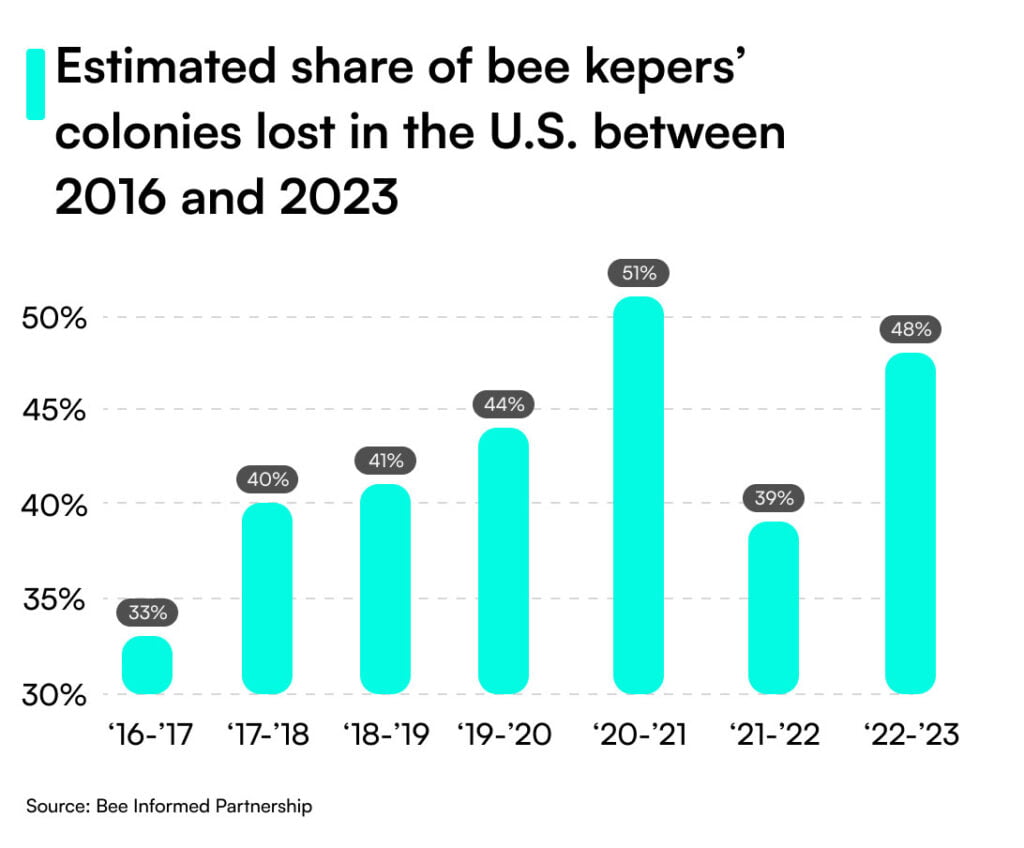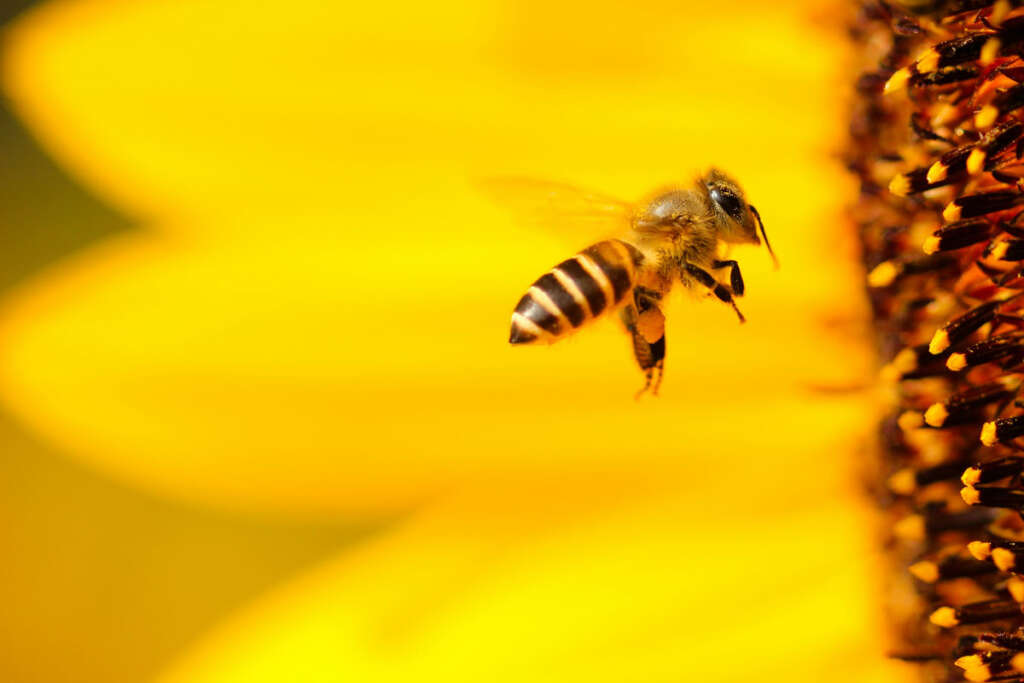Beekeepers in the U.S. experienced a loss of 48% of their managed hives from April 2022 to April 2023. This was the second deadliest year on record for U.S. honeybees. But why are bees disappearing?
First we need to point out that we shouldn’t only talk about bees. Instead, pollinator might be a more suitable term as there are many pollinators out there, not only bees. Hoverflies, solitary bees, wasps, moths, butterflies, beetles and even ants and certain vertebrates like bats can pollinate.

A German study from 2017 indicated that the number of flying insects – many of them pollinators – in the examined areas had declined by around up to 75% in the previous 25 years. This decline has serious implications for your food. Ironically, one of the possible reasons they are disappearing is your food. We will get there in a bit.
Animal pollination – how important is it?
Crops are pollinated both by animals and by wind and other means. There are even crops that are self-pollinating, like beans and peas.
Bees and other pollinators are responsible for pollinating about 75% of types of crops we grow for food. If we look at how much of the crop output is actually reliant on animal pollination, the number is much lower: 35%. This means global food security is not in a serious danger but the complete disappearance of pollinators would cause some decline in overall crop production (around 5-8% decline depending on how rich countries are).
Low dependency
Cereals (wheat, rice, maize, barley, rye, millet, oats, sorghum), sugar, roots and tubers (cassava, potatoes, carrots), lentils, peas, chickpeas, bananas, grapes, lettuce, pepper, olives, onion and many other plants are completely independent of animal pollinators. Their yields would not be affected at all by an eventual collapse.
Medium dependency
Sunflower seed, rapeseed, soybeans, strawberries, figs, currants, eggplants, coconut and coffee beans would suffer a 10% to 40% yield reduction, while this number in the case of apples, apricots, blueberries, cherries, peaches, plums, almonds, cashew, avocados, cucumber, buckwheat and nutmeg would be between 40% and 90%.
The biggest victims
Kiwi, melons, pumpkins, cocoa, brazil nuts and vanilla would basically completely disappear. Looks like chocolate would be the most hurtful loss for humans.
Natural fluctuation and beyond
Bee populations naturally increase in spring and summer, aligning with flowering periods of plants, which provide essential nectar and pollen. In winter, bee populations decline as queens and their workers retreat to hives or nests to survive the colder months. But winter losses were particularly severe during the 2022-2023 period, with 37% of hives lost. This was significantly higher than the previous year’s losses.
Why are bees disappearing?
There are many factors in play, including Varroa mite (a parasite), weather conditions, habitat destruction, pesticide use, and climate change. Even air pollution is disrupting the capacity of pollinators to detect floral scents.
And, as mentioned earlier, your food: agriculture has been using more and more chemicals, like pesticides, in order to be able to effectively meet the ever increasing demand. Pesticides, including insecticides, fungicides, and herbicides, harm pollinators by destroying important floral resources and causing a range of harmful effects on their reproduction, navigation, and memory.
Many chemicals are absorbed by plants and can be present in nectar or pollen. Over 90% of pollen samples collected from hives in areas used for agriculture have been found to contain multiple pesticides. And what’s worse, you can also easily consume these chemicals by eating food produced by conventional agriculture.

Pollinators may come in direct contact with sprayed plants, through ingestion of contaminated pollen and nectar, or exposure to contaminated nesting sites and materials. Pesticides, alone or in combination with other pesticides, can cause impaired learning, foraging, homing ability, reduced immune response or even death in many cases.
‘Inert’ ingredients in pesticide formulations can compound the effects. These additives can be labeled as non-toxic and manufacturers are often not required to disclose them, but in some cases they increase the toxicity of the active ingredients.
Wrapping up
Why are pollinator populations declining?
Pollinator populations are declining due to a combination of factors such as habitat loss, pesticides, climate change, disease, and the spread of parasites like the Varroa mite.
What is the significance of bees and other pollinators to the ecosystem and agriculture?
While their disappearance would not cause massive starvations around the world, their role in pollinating about 75% of the world’s flowering plants, including many crops, is still quite crucial. Without pollinators, chocolate would also be gone. And many of the pollinators are also important food for birds.
What can be done to help protect and preserve pollinator populations?
Protecting pollinator populations involves reducing pesticide use and environmental pollution, planting bee-friendly plants, supporting habitat conservation efforts.
In the U.S., the National Wildlife Federation recommends practical ways individuals can contribute to pollinator conservation, including planting native plants for nesting, avoiding pesticides, and engaging in citizen science efforts.
Are there any successful efforts or initiatives to save pollinators?
There are efforts and initiatives worldwide, which range from local community actions to global strategies, all designed to protect and enhance the health and habitat of pollinators such as bees, butterflies, and other insect species. Although, the light at the end of the tunnel is yet to be seen.
FAO has launched several major initiatives as part of its Global Action on Pollination Services for Sustainable Agriculture. These initiatives focus on safeguarding the diversity of pollinator habitats, promoting biological pest control to reduce pesticide use, and implementing policies favorable to pollinators. The International Pollinators Initiative (IPI 2.0) aims to promote coordinated global action to preserve managed and wild pollinators.
If you want to learn more about these initiatives have a look at FAO’s website.
Sources:


